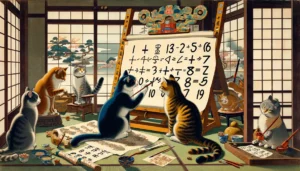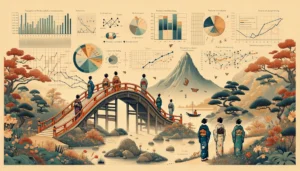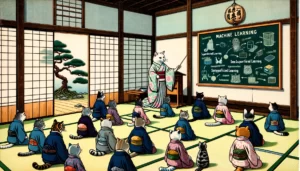ノーフリーランチ定理
全てを解決できる万能AIは存在しない
→画像データ分析:ニューラルネットワーク
→購買履歴データ分析:決定木
考える要素:目的、データの種類、データ処理方法、分析コスト →ケースバイケースで判断
An all-powerful AI capable of solving every problem does not exist. For instance:
→For analyzing image data: Neural Networks are often the go-to method.
→For analyzing purchase history data: Decision Trees might be more appropriate.
Factors to consider:
・Objective
・Type of data
・Method of data processing
・Cost of analysis
→Decisions should be made on a case-by-case basis.
「万能な解法は存在しない」
There is no one-size-fits-all solution.
想像してみてください、あなたが大きな図書館にいます。
この図書館には、あらゆる質問に答えることができる「完璧な本」があると聞きました。
でも、実際にはそんな「完璧な本」は一冊もありません。
なぜなら、世の中にはさまざまな質問があり、それぞれに特化した本が必要だからです。
数学の問題に答える本、歴史の疑問を解明する本、料理のレシピを紹介する本…。
それぞれの質問には、それぞれに適した本があります。
この図書館の話は、ノーフリーランチ定理の考え方に似ています。
つまり、すべての問題や質問に完璧に答えられる万能の解法(この場合は「完璧な本」)は存在しないのです。
一つの方法が特定の問題に対して非常に効果的であっても、
それが他のすべての問題に対しても同様に効果的であるとは限りません。
例えば、あなたが数学の問題を解決しようとしているとき、数学に特化した本を探すでしょう。
同じように、歴史のクイズに答えたいなら、歴史に関する本を選びます。
それぞれの問題には、それぞれ最適な「答え」が存在するわけです。
このように、ノーフリーランチ定理は、私たちが直面する様々な問題に対して、
一つの解法が全てに通用するわけではないということを教えてくれます。
科学やテクノロジーの世界だけでなく、日常生活においても、問題ごとに最適な解法を探す必要があるのです。
そして、それは私たちが情報を得るために使う「本」の選び方にも似ています。
全てを解決できる完璧な一冊はないけれど、それぞれの問題に最適な本は存在するというわけです。
Imagine you’re in a vast library.
You’ve heard about a “perfect book” within this library
that supposedly has the answers to any question you could ask.
However, no such “perfect book” exists.
The reason is that the world is filled with a myriad of questions,
each requiring a book specialized in that particular subject.
There are books for solving mathematical problems, unraveling historical mysteries,
and introducing cooking recipes… Each question has its own suitable book.
This library analogy is similar to the No Free Lunch theorem’s principle.
It suggests that there is no universal solution (in this case, the “perfect book”)
that perfectly answers all problems or questions.
A method that is highly effective for a specific problem might not be equally effective for all other problems.
For instance, if you’re trying to solve a mathematical problem,
you would look for a book specialized in mathematics.
Likewise, if you wanted to answer a historical quiz, you would choose a book on history.
Each problem has its own optimal “answer.”
Thus, the No Free Lunch theorem teaches us
that there isn’t a one-size-fits-all solution to the various problems we encounter.
This applies not just in the realms of science and technology but in everyday life as well.
We need to find the best solution for each problem, similar to how we choose books for obtaining information. While there isn’t a perfect book that solves everything, there are books that are best suited for specific problems.
問題(5問)
問題 1: ノーフリーランチ定理(NFL定理)が主張するのは次のうちどれか?
- A. すべての最適化アルゴリズムは、全ての問題に対して等しく良い性能を発揮する。
- B. 特定の問題に対して最適なアルゴリズムは存在する。
- C. どの最適化アルゴリズムも、全ての可能な問題に対して最適であるわけではない。
- D. 最適化アルゴリズムは不要である。
問題 2: 機械学習の文脈で、ノーフリーランチ定理に基づくと、新しい分類問題に取り組む際に最も重要なのは次のうちどれか?
- A. 最も複雑なアルゴリズムを選択すること。
- B. 過去に最も成功したアルゴリズムを選択すること。
- C. 問題に最も適したアルゴリズムを選択すること。
- D. 最も速いアルゴリズムを選択すること。
問題 3: ノーフリーランチ定理が示唆していることは、以下のアルゴリズム性能に関する記述のうち、どれが正しいか?
- A. あるアルゴリズムが一つの問題で最適なら、他の全ての問題でも最適である。
- B. 全てのアルゴリズムは全ての問題で同じ性能を発揮する。
- C. あるアルゴリズムが特定の問題に対してうまく機能するかどうかは、その問題の性質に依存する。
- D. アルゴリズムの複雑さが性能を決定する。
問題 4: 画像認識タスクとテキスト分析タスクに対して同じアルゴリズムを適用した場合、ノーフリーランチ定理によれば、どのような結果を期待するべきか?
- A. どちらのタスクも同じ性能で解決される。
- B. アルゴリズムはどちらのタスクにも最適であるとは限らない。
- C. 画像認識タスクでのみ最適な性能を発揮する。
- D. テキスト分析タスクでのみ最適な性能を発揮する。
問題 5: ノーフリーランチ定理を考慮すると、複数の問題に対処する際の最適化戦略は何か?
- A. 一つの強力なアルゴリズムを開発し、全ての問題に適用する。
- B. 各問題に対して個別に最適化されたアルゴリズムを選択する。
- C. 最もシンプルなアルゴリズムを全ての問題に適用する。
- D. アルゴリズムの選択は重要ではない。
Questions (5 questions)
Question 1: What does the No Free Lunch (NFL) theorem assert?
- A. All optimization algorithms perform equally well across all problems.
- B. There exists an optimal algorithm for specific problems.
- C. No optimization algorithm is best for all possible problems.
- D. Optimization algorithms are unnecessary.
Question 2: In the context of machine learning, according to the No Free Lunch theorem, what is most important when tackling a new classification problem?
- A. Choose the most complex algorithm.
- B. Select the algorithm that has been most successful in the past.
- C. Choose the algorithm best suited for the problem.
- D. Opt for the fastest algorithm.
Question 3: What does the No Free Lunch theorem imply about algorithm performance?
- A. If an algorithm is optimal for one problem, it is optimal for all problems.
- B. All algorithms perform the same across all problems.
- C. Whether an algorithm performs well for a specific problem depends on the nature of the problem.
- D. The complexity of an algorithm determines its performance.
Question 4: When applying the same algorithm to both image recognition tasks and text analysis tasks, what should we expect according to the No Free Lunch theorem?
- A. Both tasks will be solved with the same efficiency.
- B. The algorithm may not be optimal for either task.
- C. The algorithm will perform optimally only for image recognition tasks.
- D. The algorithm will perform optimally only for text analysis tasks.
Question 5: Considering the No Free Lunch theorem, what is the best strategy when dealing with multiple problems?
- A. Develop one powerful algorithm and apply it to all problems.
- B. Choose individually optimized algorithms for each problem.
- C. Apply the simplest algorithm to all problems.
- D. The choice of algorithm is not important.







